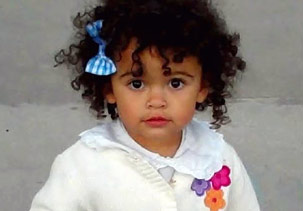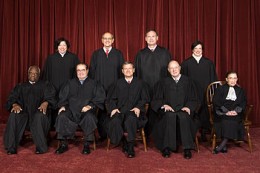Supreme Court loses sight of ‘best interest’ in adoption case

Supreme Court loses sight of ‘best interest’ in adoption case
Twenty three years on the juvenile and family court bench, five of which were spent doing adoptions, provide a basis for this comment on the Supreme Court’s decision in the Baby Veronica case.1 In June, 2013, the Court handed down a 5 to 4 ruling that the parental rights of the girl’s Indian birth father could be terminated in state court and that the Indian Child Welfare Act of 1978 (ICWA) did not apply and was not a bar to the child’s adoption by a non-Indian family.
The facts of this case are fairly straightforward. Baby Veronica was born in September, 2009 to an unmarried Hispanic mother and her father, a member of the Cherokee Nation. Her parents were engaged but the mother called it off several months after telling the father that she was pregnant. She texted him asking if he wanted to pay child support or relinquish his rights. He responded by text message saying he would relinquish his parental rights but thought the relinquishment was to her. No mention of adoption by another person or persons was made.
The father, Dusten Brown, was active duty in the military. Four days before deploying to Iraq he was served with papers that included notice of a pending adoption. This was the first he heard about an adoption of his daughter. Apparently the child’s mother decided before birth to place her for adoption. The non-Indian couple selected by the mother was present at her birth and took her home to South Carolina shortly thereafter.
Brown signed the documents not realizing he was signing adoption papers. When told what they were he tried to take them back from the process server but was told he couldn’t. The next day, he contacted a lawyer to stop the adoption. He wanted custody of his daughter and submitted to a paternity test showing he was the child’s father. The case went to family court where the petition to adopt was denied and custody was awarded to Brown. The lower court ruled that the adoption petitioners failed to comply with the requirements of ICWA. The child was placed with her father at the end of December, 2011. Contrary to media reports about this case, the prospective adoptive parents did not adopt this child.
Baby Veronica spent twenty-seven months in the home of the adoption petitioners, Matt and Melanie Capobianco in South Carolina. By the time of the Supreme Court’s ruling in June, 2013, she was three and a half years old, having spent 18 months with her father and paternal grandparents in Oklahoma. The Court’s decision does not automatically return the child to the Capobiancos. The case was returned to the courts in South Carolina “for further proceedings not inconsistent with this opinion.” It will be up to the lower courts to determine Veronica’s placement. Of course, this will result in further litigation which means additional time to decide Veronica’s fate. In the meantime she will likely remain with her father and grandparents during these crucial months and years in her development.
It should be noted that since the establishment of the first juvenile court in Chicago in 1899, the bottom line in juvenile justice evolved from punishment and retribution to what’s in the child or juvenile’s best interests. Whether the child is in court for being abused or neglected, as an incorrigible child or for committing crimes, the underlying goal is rehabilitation, direction with consequences, safety and the best interests of the child. Even hearings involving name changes are based on what’s in the child’s best interests.
This is especially true in every adoption case. In fact, most states require children over a certain age (12, for example) to appear in court at the adoption hearing and give their consent to the adoption. For younger children it is assumed that some of the parties involved in the adoption speak for the child and what’s in his or her best interest. That is why reports from adoption agencies, guardians ad litem and attorneys are filed before the adoption is finalized. Best interest of the child is paramount in most juvenile matters but particularly in adoption cases.
That being said, it is interesting that the majority in Baby Veronica’s case mentioned “best interests” only two times. The first time is of no consequence since it was in reference to the legislative history of the ICWA. The second time was when they were criticizing Mr. Brown for playing “his ICWA trump card at the eleventh hour to override the mother’s decision and the child’s best interests.” Deciding a case about adoption without discussing “best interests of the child” is like deciding a First Amendment free speech case regarding students without mentioning the landmark Tinker2 decision, or deciding an abortion case without referencing Roe v. Wade.3
The majority decided the case by taking two sections of ICWA and mechanically parsing a few words in each. In applying the facts of the case to the Court’s definition of “custodial parent’s rights” and “breakup of the Indian family” they concluded that ICWA doesn’t apply to Dusten Brown because he never had physical or legal custody of Veronica and that, therefore, there was no relationship to “breakup.” These are both arguable points as you can see by reading the full opinion including the dissenting comments of Justices Sotomayor and Scalia.
This case isn’t over as Sotomayor points out. The paternal grandparents may file their own petition to adopt the child. If they do, what is in Veronica’s best interest is the key factor in deciding her future. Unfortunately, Veronica’s history can’t be undone. But further delay can be mitigated if everyone involved keeps this little girl in mind rather than the mechanics of ICWA when its interpretation is in dispute. This is not a contract or liability case where the loser writes a check to the winner. The heart of this case is just that: it’s about a little, vulnerable girl whose heart and soul deserve protection.
Justice Sotomayor concluded her dissent as follows: “However difficult it must have been for her to leave Adoptive Couple’s home (the Capobiancos) when she was just over 2 years old, it will be equally devastating now if, at the age 3 and a half, she is again removed from her home and sent to live halfway across the country. Such a fate is not foreordained, of course. But it can be said with certainty that the anguish this case has caused will only be compounded by today’s decision.”
As Veronica gets older and the familial bonds strengthen with her father and grandparents, her best interest grows in importance. Surely, the South Carolina Supreme Court and family court will take this into consideration. The Capobiancos are undoubtedly a fine family with a deep love of the child. However, parental rights must prevail over the desires of a non-family party seeking adoption of the child. As Justice Scalia commented, “It has been the constant practice of the common law to respect the entitlement of those who bring a child into the world to raise that child …….This father wants to raise his daughter, and the statute amply protects his right to do so.”
An earlier case4 before the Supreme Court involved severe physical abuse of a four-year-old boy. He was beaten by his father and is now institutionalized with physical and mental disabilities. Joshua’s mother sued the state for not protecting Joshua from his father. Justice Harry Blackmun lamented in his dissent “Poor Joshua!” regarding his treatment and the Court’s majority view that the U.S. Constitution does not protect children from abuse by their parents (it’s a matter left to the states).
If this case returns to the Supreme Court for review regarding best interests, let’s hope there isn’t a need to say “Poor Veronica!”
Update as of July, 2013: The South Carolina Supreme Court ordered that the case be returned to the state Family Court so that a final adoption by the Capobiancos can be completed. The legal wrangling in this case has just begun and it could very well be back before the U.S. Supreme Court within the next year. The Cherokee Nation, father, grandparents and other agencies are requesting that a “best interest” determination be made by the court. In an adoption case this seems like a no-brainer. On July 31, 2013, the family court in South Carolina finalized the adoption of Veronica by the Capobiancos. A schedule to reintroduce her to her new parents was set up and she is expected to return to their home soon.
The final words from the U.S. Supreme Court on the father’s request for rehearing were issued on August 2, 2013:
We wish Veronica the best in life and hope the pain suffered by many in this case eases over time.
Read more: http://www.kjrh.com/dpp/news/local_news/us-supreme-court-denies-dusten-browns-adoption-challenge-in-struggle-for-baby-veronica#ixzz2awyQ20wV
1Adoptive Couple v. Baby Girl, 133 S.Ct. 2552 (June 25, 2013).
2Tinker v. Des Moines Independent Community School District, 393 U.S. 503 (1969).
3Roe v. Wade, 410 U.S. 113 (1973).
4Joshua Deshaney v. Winnebago County Department of Social Services, 489 U.S. 189 (1989).




